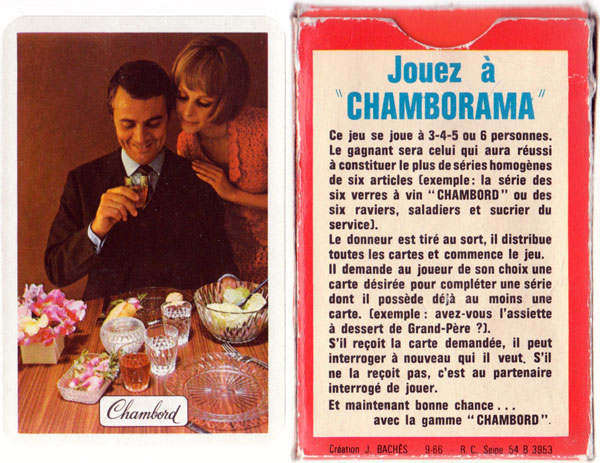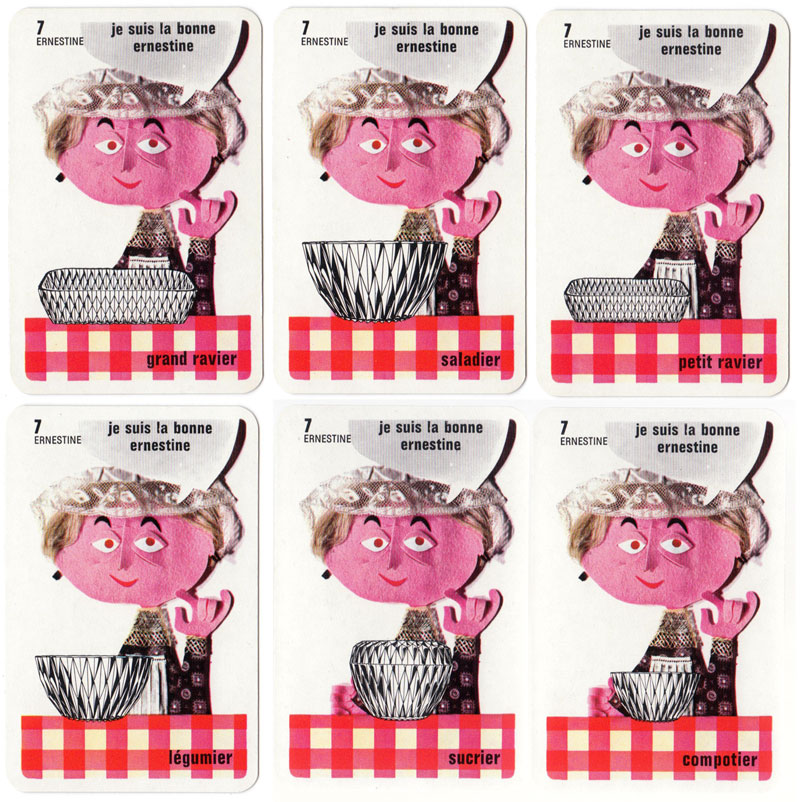Chamborama
This “Jeu de Familles” from the 1960s designed by Jean Bachès promotes Chambord glassware.
Chamborama, 1966
This “Jeu de Familles” from the 1960s promotes Chambord glassware. The object of the game is to complete family sets of the same item (wine glasses, small dishes, larger dishes, sugar bowls, etc) by asking opponents for a particular card, for example: “avez-vous l'assiette à desert de Grand-Père?"

Above: the reverse of the cards and back of the box. All images courtesy Rex Pitts.
The signature on the Monsieur and Grand-Père Chambord cards is that of Jean Bachès, the artist and graphic designer.

By Rex Pitts (1940-2021)
Member since January 30, 2009
Rex's main interest was in card games, because, he said, they were cheap and easy to get hold of in his early days of collecting. He is well known for his extensive knowledge of Pepys games and his book is on the bookshelves of many.
His other interest was non-standard playing cards. He also had collections of sheet music, music CDs, models of London buses, London Transport timetables and maps and other objects that intrigued him.
Rex had a chequered career at school. He was expelled twice, on one occasion for smoking! Despite this he trained as a radio engineer and worked for the BBC in the World Service.
Later he moved into sales and worked for a firm that made all kinds of packaging, a job he enjoyed until his retirement. He became an expert on boxes and would always investigate those that held his cards. He could always recognize a box made for Pepys, which were the same as those of Alf Cooke’s Universal Playing Card Company, who printed the card games. This interest changed into an ability to make and mend boxes, which he did with great dexterity. He loved this kind of handicraft work.
His dexterity of hand and eye soon led to his making card games of his own design. He spent hours and hours carefully cutting them out and colouring them by hand.
Related Articles

Dancing
“Dancing” playing cards manufactured by Nintendo for Torii Dance School, Osaka.

Agent Provocateur
Branded lingerie collection in a pack of pin-up playing cards.

Shin-Tōmei Expressway Opening Commemoration
Promotional playing cards for the Shin-Tōmei Expressway, a major Japanese expressway that opened in ...

Caisse Mutuelle d'Assurance et de Prevoyance
Insurance propaganda pack for Caisse Mutuelle d'Assurance et de Prevoyance with humorous artwork by ...

Copechat Paramount Sorting System
Preserving the past: a specimen deck showcasing edge-notched cards and their ingenious sorting syste...

Heartsette by Herbert Fitch & Co, 1893
A glimpse into a busy print and design office in late Victorian London.

Intersigma
A Czech advertising deck for a company dealing with pump technology.

Jeu Révolutionnaire
Court cards and aces from a French Revolutionary pack by Pinaut, Paris, c.1794.

French Revolutionary cards by Pinaut
Seven cards from a French Revolutionary pack by Pinaut featuring characters from classical antiquity...

The European Interchanges Quartets
A card game based around motorway intersections from European countries.

Briefmarken-Quartett
Quartet game featuring postage stamps from the Zones of Occupation in post-WWII Germany.

Never Mind the Belote
Limited edition Belote pack with designs by a collective of 24 street artists.

Sannois dans les étoiles
Celebrities and buildings associated with Sannois, a commune in the suburbs of Paris.

Le Globe Céleste
Views and plans of five international exhibitions held in Paris between 1855 and 1900.

IG Chemie Papier Keramik
Promotional pack designed by Karl-Heinz Schroers for a German trade union with comical bears on the ...

Le Journal de Mickey
Perforated sheet of cards with Disney characters issued with the magazine Le Journal de Mickey.
Most Popular
Our top articles from the past 28 days








